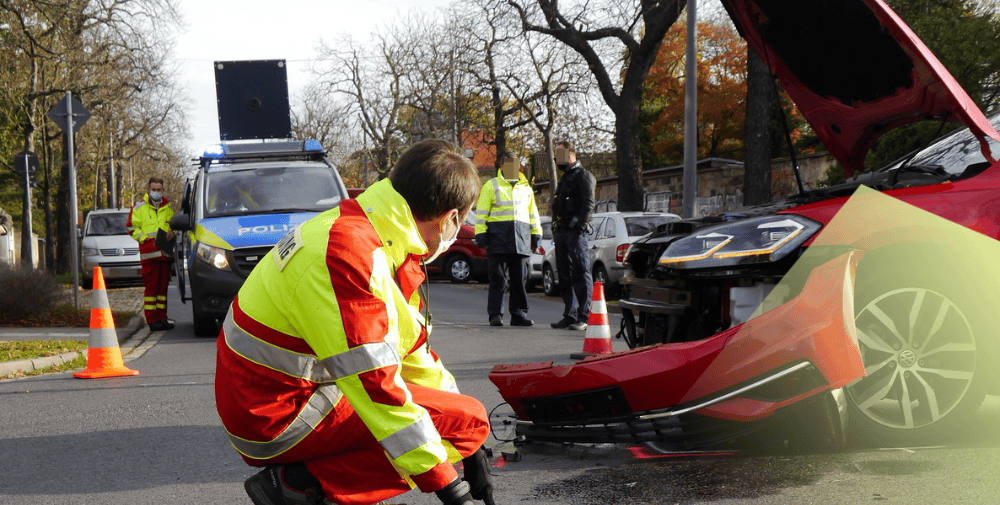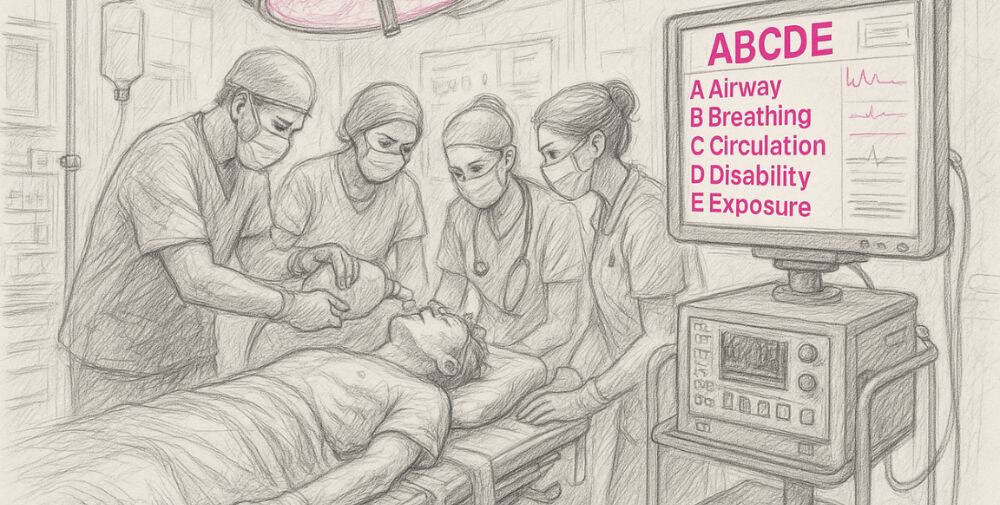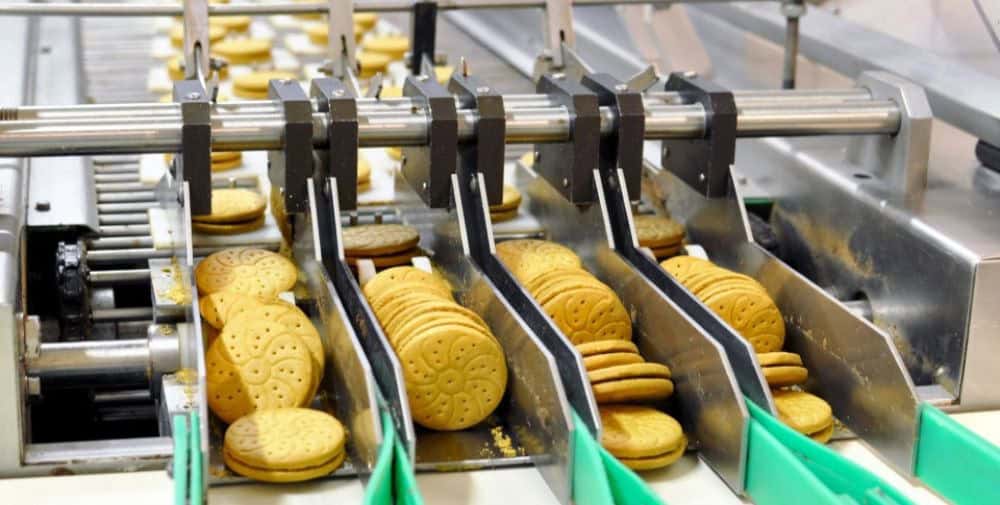Dresden and the surrounding area as an optimal German landscape and traffic average
It was not only the excellent reputation of Dresden University and the local hospital that convinced the tendering process at the time. The selected survey area – the city of Dresden and its “bacon belt” within a radius of around 35 kilometers – also seemed perfect for German road accident research. “The city and the surrounding area represent the German average very well. All relevant topographical features, road types and traffic conditions are present here,” explains Henrik Liers, Managing Director of VUFO GmbH. The fact that traffic has increased by a factor of ten since the 1970s, but road fatalities have fallen by almost the same factor in the same period, is also thanks to Dresden’s accident research and the knowledge it has gained. Every year, the employees and vehicles of VUFO GmbH are called out to 1,000 incidents, always accidents involving personal injury. On average, 3,500 individual pieces of information are recorded during an operation at an accident scene, divided into around 1,700 technical parameters, 500 medical parameters and around 300 psychological parameters. Since the start of the project in 1999, more than 45,000 accidents have been documented at the sites in Dresden and Hanover. A treasure trove of data has been created that has already contributed to significantly safer vehicles and traffic infrastructures. However, it was only increasing digitalization that opened up the possibilities that are still saving lives today. In the early days of the project, accident data was still largely recorded in analog form – files were created, information was stored on punch cards, prints of photos were attached – but now everything is digital and can be retrieved in impressive detail with just a few clicks and using clear dashboards.

Vehicle technician from Traffic Accident Research inspects a vehicle involved in an accident. Photo: VUFO GmbH
Medical and technical teams record accident data, also in Munich and Hanover
A team of vehicle technicians and doctors is deployed to every Dresden accident research operation. Once at the scene of the accident, the team splits up. While the technical crew records the vehicles involved, their damage and data on weather, road conditions and skid marks, for example, using drone technology, laser scanners and 3D photogrammetry, the medical team member takes care of the people involved in the accident as well as their injuries, accident impressions and psychological aspects. Much of the data to be recorded is entered directly into the GIDAS database on site using a tablet PC. Others are later extracted and documented from photos, videos or voice recordings in the VUFO offices. Since 2023, accident research has also been carried out at a third location in Munich as part of the GIDAS project. Here, too, Dresden’s expertise enables the recording of 500 accidents per year. However, the team in Dresden wants to continue to set the pace for the GIDAS project – also thanks to smart technologies from Saxony.

A bicycle accident on the Elbe in Dresden. VUFO GmbH is on site with a medical and a technical team. Photo: VUFO GmbH
The UNIDATO® data acquisition system used for accident recording was developed more than 15 years ago in close cooperation with Dresden-based Trans4mation IT GmbH. In 2021, the TASC database (Traffic Accident and Scenario Community) was also launched with the Fraunhofer IVI – a platform that, unlike the GIDAS database, combines traffic observation and accident data, including data from accidents without personal injury.
Technology “made in Saxony” facilitates data entry and presentation
The UNIDATO® data acquisition system, developed by Trans4mation IT GmbH, facilitates the entry of around 3,500 individual pieces of accident data and feeds them into the GIDAS database. To prevent incorrect entries, the data is checked for plausibility (e.g. if it is raining, the road cannot be dry). To save time, the data entered is – as far as possible and necessary – automatically adopted in all relevant input fields or sample data records are made available. The UNIDATO® system is now so successful that it is not only used by VUFO, but also by car manufacturers such as VW, Skoda, Audi and Mercedes. This is because many vehicle manufacturers also carry out accident reconstructions and damage surveys, albeit on a smaller scale and with a strong focus on the needs of car manufacturers.
Accident reconstruction with a moving target based on VUFO accident data. Video: DEKRA
The GIDAS database is the world’s largest and most detailed platform for accidents involving personal injury. The more than 45,000 documented accidents now provide information on all accident types and parties involved, traffic situations, injuries, damage and their causes. The findings and results obtained from this survey are incorporated into the further development of road safety measures and European legislative initiatives via the Federal Highway Research Institute (BASt). At the same time, they serve as a basis for new vehicle safety and assistance systems that are developed and brought to market by the member companies of the Forschungsvereinigung Automobiltechnik e.V. (FAT).
The TASC platform also provides further important information that is necessary for the development, validation and testing of assisted and automated driving functions. The data stored here comes from police accident records, data from traffic observations and data from weather services. TASC is thus an information pool that not only contains all accident scenarios (including those without personal injury), but also includes all traffic situations and variations, from harmless to critical scenarios to actual accidents. For the first time, the scientific partner, the Fraunhofer Institute for Transportation and Infrastructure Systems (IVI), succeeded in evaluating the criticality of driving scenarios. In other words, the validation of how close a driving scenario is to an accident or how far away the point of no return – the point at which an accident is unavoidable – is. All this information can be converted into simulation files using specially developed processes and scientific methods. In addition, the Fraunhofer IVI has also developed a methodology with which up to 900 variations of how the accident could have physically occurred can be generated from a real accident data set. This data can be used for statistical analyses and for vehicle and scenario simulations, for example.
GIDAS and TASC provide various customer groups with valuable information
“We are currently in the process of creating one of the world’s most comprehensive ecosystems with combined accident and driving scenarios. The development time of several years has paid off, because we had an eye for the multivalent challenges of autonomous driving and their consequences right from the start,” says André Rauschert, Head of Digital Processes at Fraunhofer and technological sparring partner in the development of TASC. The data from TASC and GIDAS is of interest to vehicle manufacturers and suppliers, associations and regulatory authorities, as well as cities, municipalities and local authorities. “A crash test quickly costs around 100,000 euros. With our OpenX data sets, almost any accident scenario can now be digitally simulated without any problems and in a non-destructive manner. We handle around 80 percent of our customer projects with automotive manufacturers and suppliers. Most of these projects involve the development and optimization of driver assistance, safety or emergency systems. However, we also support cities and local authorities in the redesign of traffic infrastructures by not only pointing out danger spots, but also highlighting their problems,” explains Henrik Liers. “Depending on the customer and customer requirements, we not only provide the data, but also analyze it or refine it in special formats. We offer further training in the areas of vehicle and road safety. We advise automotive companies or partners commissioned with the construction or expansion of traffic infrastructures. The data we collect is therefore the basis of our business model and a way of making road traffic safer year on year.”
OpenX data set of an accident. Video: VUFO GmbH
VUFO continues to expand its business models – The international market beckons
The GIDAS data generated by VUFO is also used by institutions and authorities at national and European level. For example, the Federal Highway Research Institute (BASt) uses the data to develop the necessary standards, guidelines and rules for road traffic in Geneva and Brussels. Accident prevention is also becoming increasingly important. Here, VUFO supports professional associations, among others, with data-driven approaches. Last year, the emergency physician indication catalog valid in Germany was revised together with medical committees with the help of VUFO. In short: new ways of protecting people from accidents or their consequences are constantly being explored. The aim of VUFO GmbH is to continue along this path in the coming years and to internationalize it. The focus here is on validating more European driving scenarios with the methods developed in Saxony and expanding them with the existing data or increasing their variance – be it in the integration of wildlife crossings or different commercial vehicle classes.
1.19 million people still die in road traffic worldwide every year. Many of these tragedies could be prevented or at least mitigated. The necessary data, systems and their possibilities are often already available. Various traffic concepts, infrastructure elements and vehicle systems and functions can be put through their paces with the help of the data platforms and visualizations developed by VUFO GmbH and the Fraunhofer IVI. There is hardly an accident or hazard scenario that cannot be simulated on the basis of this valid data and addressed with suitable measures using the knowledge gained. It is high time that not only automotive companies used this wealth of knowledge to optimize their vehicles. There is also a need for cities, municipalities, local authorities and federal states to use data-driven approaches to address deficits in the area of road safety. After all, every accident is one accident too many.
Contacts
Traffic Accident Research at TU Dresden GmbH
Semperstr. 2a
01069 Dresden
Phone: +49 351 4389890
Email: info@vufo.de
Trans4mation IT GmbH
Glashütter Straße 55
01309 Dresden
Phone: +49 351 501940
Email: info@trans4mation.de
– – – – –
Further links
👉 German In-Depth Accident Study (GIDAS)
👉 Traffic Accident and Scenario Community (TASC)
👉 Services of VUFO GmbH
👉 Products of VUFO GmbH
👉 UNIDATO®
👉 Fraunhofer IVI, Vehicle and Traffic Safety
Photo: VUFO GmbH
– – – – –
This article was written exclusively for “NEXT In Focus: Software”.
👉 To the complete issue of the magazine



